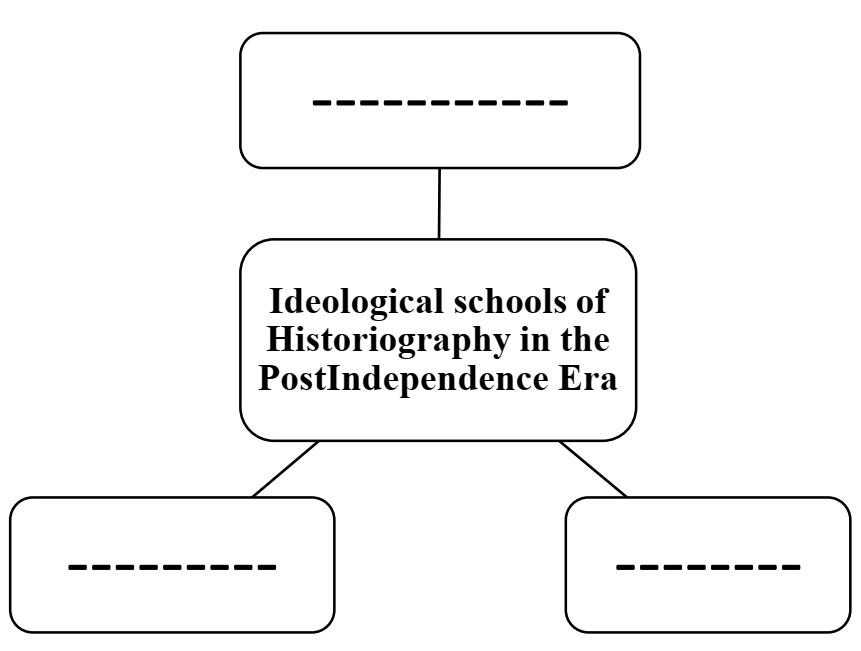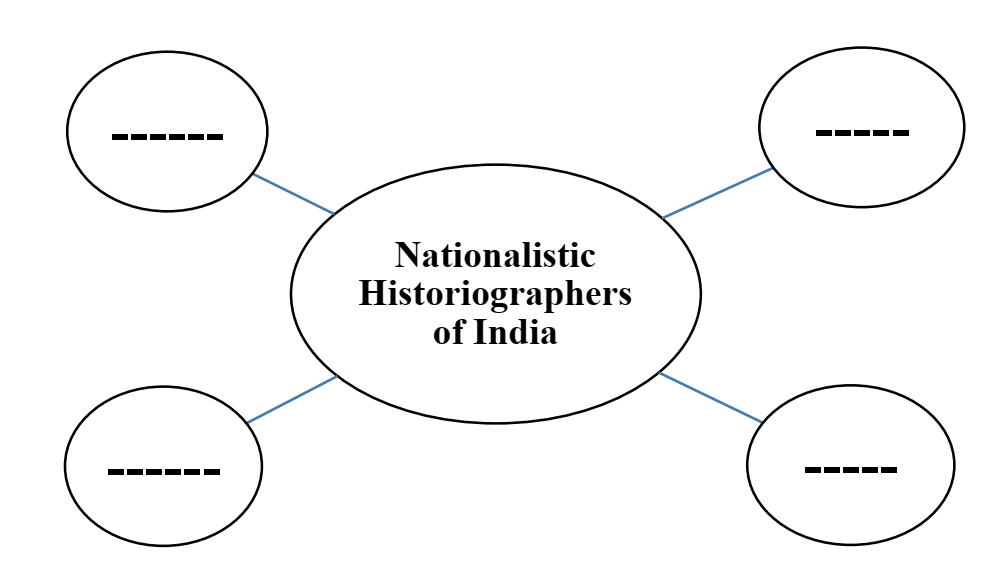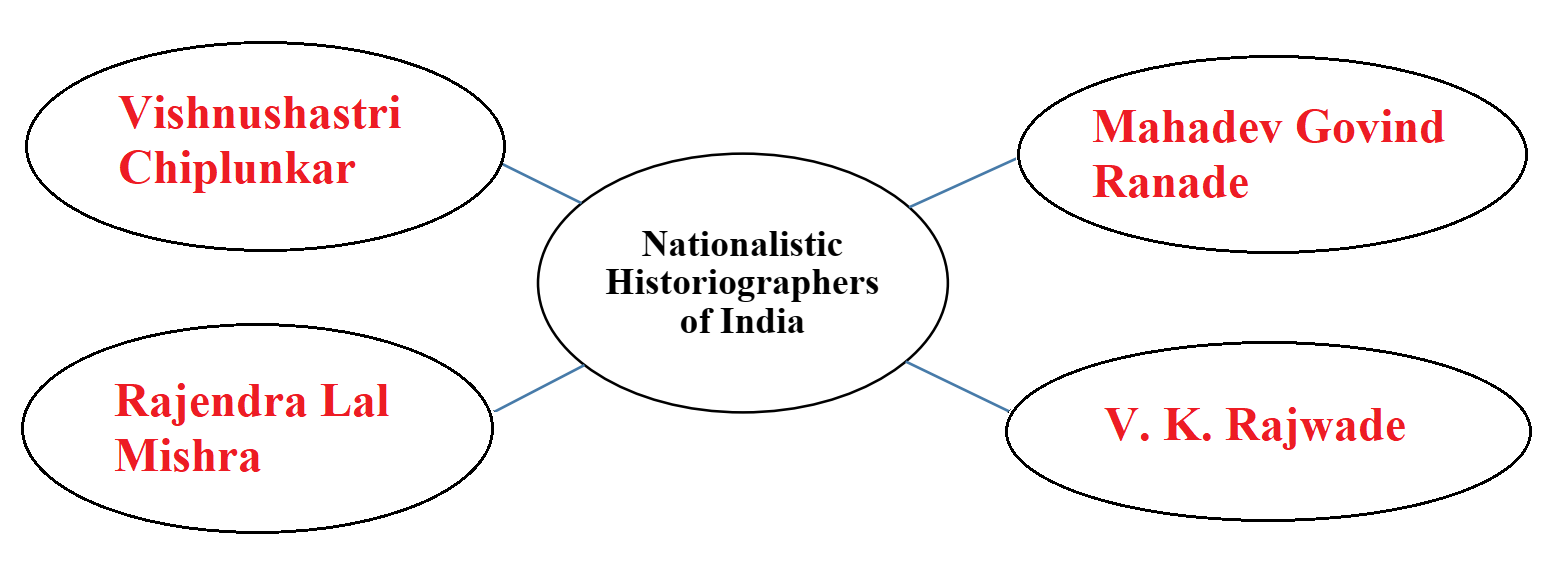Chapter : 2. Historiography : Indian Tradition
Q.l. (A) Choose the correct option from the given options and complete the sentences.
1. ……………. was the first Director General of the Archaeological Survey of India.
(A) Alexander Cunningham (B) William Jones (C) John Marshall (D) Friedrich Max Muller
2. ……………. translated the Sanskrit text of ‘Hitopadesh’ in German language.
(A) James Mill (B) Friedrich Max Muller (C) Mountstuart Elphinstone (D) Sir John Marshall
3. Rajtarangini is the history of ……………..
(A) Kashmir (B) Bengal (C) Maharashtra (D) Rajastan
4. Mahatma Phule unfolded the history of the ‘shudratishudra’ commuunities in his book ……………..
(A) The Untouchables (B) Who Were the Shudras (C) Gulamgiri (D) StripurushTulana
5. Nationalistic writings in Maharashtra were inspired by ……………..
(A) Vishnushastri Chiplunkar (B) V. K. Rajawad (C) Tarabai Shinde (D) G. S. Sardesai
(B) Identify the wrong pair in the following and rewrite.
(1)
i. ‘Who were the Shudras’ – Dr BabasahebAmbedkar
ii. ‘Stri-PurushTulana’ – Feminist writing
iii. ‘The Indian War of Independence 1857’ – Marxist Historyiv.
iv. Grant Duff – Colonial History.
Ans. Wrong pair: ‘The Indian War of Independence 1857’ – Marxist History
(2)
i. Mahatma Phule – Gulamgiri
ii. Dr BabasahebAmbedkar – Who Were the Shudras
iii. PanditaRamabai – StripurushTulana
iv. GovindSakharamSardesai – Marathi Riyasat
Ans. Wrong pair: Pandita Ramabai – StripurushTulana
(3)
i. ZiauddinBarani – ‘Tarikh-i- Mubarakshahi’
ii. HasanNizami – ‘Tajul-Ma’asir’
iii. Minhaj-i-Siraj’- ‘Tabaqat-i-Nasiri’
iv. Timur (-i) Lang – ‘Tuzuk-i-Timuri’
Ans. Wrong pair: Ziauddin Barani – ‘Tarikh-i-Mubarakshahi’
(4)
i. Sir Alexander Cunningham – Ancient sites were excavated
ii. MountstuartElphinstone – The Governor of Bombay (Mumbai)
iii. Sir William Jones – Founder of Asiatic society
iv. Friedrich Max Muller – Translated ‘Hitopadesh’ in French.
Ans. Wrong pair: Friedrich Max Muller – Translated ‘Hitopadesh’ in French
Q2. (A) Do as instructed.
1. Complete the following table chart.

Ans.

2. Complete the following table chart.

Ans.

3. Complete the following table chart.

Ans.

4. Complete the following table chart.
Ans.

Q. 2. (B) Write short notes on
1. Orientalist historiography
Ans: The European scholars who had curiosity, admiration and respect for the civilisations and countries of the East are known as ‘Orientalists’,
(1) They focused on Vedic tradition and Sanskrit literature and also studied the similarities between Sanskrit and some of the European languages. These studies formulated a notion about an ancient language that could be the origin of all Indo-European languages.
(2) The Asiatic society founded by Sir William Jones in 1784 in Kolkata, opened the doors for research in ancient Indian literature and history.
(3) According to the Orientalist scholar, Friedrich Max Muller, Sanskrit was the most ancient language of the Indo-European languages. He was deeply interested in Sanskrit literature and translated the Sanskrit text of Hitopadesh in German and was the editor of 50 volumes of ‘The Sacred Books of the East’. Muller compiled and published Rigveda in six volumes as well as translated it in German.
(4) However, a scholar named Edward Said re-evaluated the orientalist writings and highlighted the imperialistic interests of orientalist scholars.
2. Nationalistic historiography
Ans:
(1) Nationalistic Historiography includes the writings of Indian historians who were trained in the British educational system. They aimed at restoring the pride in the ancient glory of India and self-esteem of the Indian readers.
(2) The nationalistic historians tried to seek the golden era of Indian history, although at times, they ignored the critical analysis of the historical truth. Nationalistic type of historiography also helped in triggering the Independence movement of the Indian people against the British. For e.g. The Indian War of Independence, 1857’ written by Vinayak Damodar Savarkar.
(3) Moreover, the writing of regional histories gained momentum due to the nationalistic historiography and drew attention of the historians to the geographic conditions & history of south Indian regions.
(4) Vishnushastri Chiplunkar who criticised the prejudiced history of ancient India written by British officers, inspired nationalistic writings in Maharashtra.
(5) Some other renowned nationalist historians include Mahadev Govind Ranade, Ramkrishna Gopal Bhandarkar, Ramesh Chandra Majumdar, Rajendra Lal Mishra, Kashi Prasad Jayswal, Radha Kumud Mukherjee, Anant Sadashiv Altekar, Bhagawan Lai Indraji, Vasudev Vishnu Mirashi and V. K. Raj wade.
3. Subaltern history
Ans:
(1) Subaltern means the ‘bottommost ranks’ and subaltern history developed from the idea that history should be written from the bottommost rank of people in the society. This idea was developed by the Italian historian Antonio Gramsci.
(2) The seeds of subaltern history are supposed to be found in the Marxist historiography.
(3) One of the important sources of writing subaltern histories is the folklore.
(4) The Indian historian, Ranjit Guha, played a major role in establishing subaltern history as an important academic school of historiography.
(5) Prior to him, similar thoughts were expressed by Mahatma Jyotirao Phule and Dr. Babasaheb Ambedkar.
(6) Mahatma Phule drew attention to the exploitation of women, shudras and atishudras done under the name of religion. In his book, Gulamgiri, Mahatma Phule unfolded the history of the shudratishudra community. The terms shudra and atishudra indicates the bottom most ranks in the caste system.
(7) Dr. Babasaheb Ambedkar wrote about the role of people belonging to Dalit castes in shaping the various cultural and political aspects of India which was neglected in the colonial and nationalistic historiography. The issues faced by the Dalit caste are mentioned in two books ‘Who Were the Shudras’ and ‘The Untouchables’, written by Dr. Babasaheb Ambedkar.
4. Colonial Historiography
Ans:
(1) British officers and Christian missionaries were the early scholars who studied and wrote Indian history.
(2) However, their approach was prejudiced, which is apparent from their writings which ridiculed the Indian culture.
(3) The colonial rule of the British was justified through their writings.
(4) Examples of colonial historiography include the following:
a. The five volumes of Cambridge History of India, published during 1922-1937 C.E.
b. The three volumes of ‘A History of Mahrattas’ written by the British officer Grant Duff.
c. Colonel Todd’s writings about Rajasthan’s history.
Q.3. Explain the following statements with its reason.
1. Writing of the regional history received a momentum.
Ans:
(1) Nationalistic Historiography, which includes the writings of Indian historians trained in the British educational system, tried to restore the pride in the ancient glory of India and self-esteem of the Indian readers.
(2) Vishnushastri Chiplunkar, who criticised the prejudiced history of ancient India written by British Officers, inspired the nationalistic writings in Maharashtra.
(3) Justice Ranade wrote the book, ‘The Rise of Maratha Power’, which explained the background of the rise of Maratha empire.
(4) Thus, nationalistic historiography provided a momentum to the writing of regional histories, which drew the attention of historians to the geographic conditions and history of south Indian regions.
2. Bakhar is an important type of historical documents.
Ans:
(1) Bakhar wrote in medieval times. It contains eulogies of the heroes as well as stories of historic events, battles and lives of great men.
(2) The various types of bakhars include dynastic history, biographies of kings, history of a sect, descriptions of events, autobiographies, regarding grievance, based on mythologies and state administration by a king.
For e.g. Sabhasad Bakhar is about the rule of Chhatrapati Shivaji Maharaj whereas Bhausahebanchi Bakhar as well as Panipatachi Bakhar describes the Battle of Panipat. Holkaranchi Kaiphiyat is about the Holkars and their contributions to the Maratha rule.
Thus, we get information about rulers and their reign through ‘Bakhar’. Therefore, it is an important type of historical documents.
3. Rajtarangini is quite close to the concept of modern historiography.
Ans:
(1) Rajtarangini is writtem by Kalhana in the 12th Century C.E.
(2) It is about the history of Kashmir.
(3) He wrote the text after critically examining the various sources like inscriptions, coins, dynastic records, remains of ancient monuments and local traditions.
Therefore, the style of writing of this text was similar to the concept of modern historiography.
4. People began to address G. S. Sardesai as ‘Riyasatkar’.
Ans:
(1) Govind Sakharam Sardesai published several volumes of Maratha history.
(2) He also published the Marathi Riyasat which was a momentous achievement in the field of Indian Historiography.
(3) It is this book which became so famous that people began to address him as ‘Riyasatkar’.
Q.4. Read the following extract and answer the questions below.
Sohagaura Copper-plate
The copper-plate was found at Sohagaura (District Gorakhpur, Uttar Pradesh). It is supposed to be from the Mauryan period. The inscription on it is in Brahmi script. The symbols known as ‘Tree-in-railing’ and ‘Mountain’ at the beginning of the inscription also occur on punch marked coins. Another symbol which looks like a structure erected on four pilars is
supposed to be indicative of a granary. The inscription records a royal order that the grains stored in the granary should be distributed carefully. It is supposed to be suggestive of precautions taken in the times of a famine.
1. In which state was the Sohagaura copper plate found?
Ans: The Sohagaura copper-plate was found in Uttar Pradesh.
2. Where else can you find the marks found on the Sohagaura copper plate?
Ans: The marks that found on the Sohagaura copper plate also find on punch marked coins.
3. Which history we can know from Sohagaura copper plate?
Ans: i. As the Sohagaura copper plate is supposed to be from the Mauryan period we get the information about the political, social and economic condition of this period.
ii. The inscription records a royal order that the grains stored in the granary should be distributed carefully which is suggested the precautions taken in the time of a famine.
Q.5. Answer the following questions in details.
1. What is Marxist History?
Ans: Introduction: Marxist history is one ideological school which influenced the historiography of the post-independence era.
(1) The basic theme of Marxist historiography is to analyse the impact of every social event of significance.
(2) The writings of Marxist historians centred around the concern for the means of production, modes of production and the industrial relations.
(3) In India the Marxist historians studied the transitions within the caste system. Some of the notable Indian historians who adopted Marxist ideological framework are Damodar Dharmanand Kosambi, Comrade Shripad Amrut Dange, Ram Sharan Sharma, Comrade Sharad Patil, etc. The book, Primitive Communism to Slavery, written by Comrade Dange represents Marxist historiography.
Conclusion: In this way the ideology of Marxist history had a deep impact on Indian history.
2. What is the contribution of Itihasacharya V.K. Rajwade to historiography?
Ans: Introduction: V. K. Rajwade wrote in Marathi on varied subjects like history, linguistics, etymology, grammar, etc.
(1) He firmly stated that we should write our own history and accordingly, he compiled and edited 22 volumes of Marathyanchya Itihasachi Sadhane and wrote scholarly prefaces to each volume.
(2) He maintained that –
a. History is the all-inclusive image of the past societies and is not based only on the stories of political images, conspiracies & wars for seizing power.
b. According to him, an event qualifies to be an historical event if it presents a balanced combination of the three factors, Time, Space and Personalities.
(3) He insisted on writing history based on only authentic documentary source. On 7th July 1910, he founded ‘Bharat Itihas Samshodhak Mandal’ in Pune to facilitate historical research.
Conclusion: In this way the ideology of Nationalistic. Historians had a dee impact on Indian history.
3. Write information about post-independence feminist historiography.
Ans:
(1) In the post-independence era, issues like employment of women, treatment meted out to them at their work place, their right to political equality, etc. was reflected through feminist literature.
(2) The recently published feminist literature contains:
a. Meera Kosambi’s book, ‘Crossing Thresholds: Feminist Essays in Social History’ which contains essays on the life stories of women like Pandita Ramabai and Dr. Rukhmabai (the first practicing lady doctor of India).
b. Literature unfolding the viewpoint of Dalit women in Maharashtra. For e.g. Dr. Sharmila Rege’s book, ‘Writing Caste, Writing Gender, Reading Dalit Women’s Testimonies’ which includes her essays on the autobiographies of Dalit women.
4. Explain the features of nationalist historiography.
Ans: The features of nationalist historiography are as follows:
(1) Indian historians: Nationalistic Historiography includes the writings of Indian historians who were trained in the British educational system.
(2) Aim of writing: They aimed at restoring the pride in the ancient glory of India and self-esteem of the Indian readers.
(3) Specific work: The nationalistic historians tried to seek the golden era of Indian history, although at times, they ignored the critical analysis of the historical truth. Nationalistic type of historiography also helped in triggering the Independence movement of the Indian people against the British. For e.g. ‘The Indian War of Independence, 1857’ written by Vinayak Damodar Savarkar.
(4) Momentum to regional history writing: Moreover, the writing of regional histories gained momentum due to the nationalistic historiography and drew attention of the historians to the geographic conditions & history of south Indian regions.
(5) Work of Vishnushastri Chiplunkar: Vishnushastri Chiplunkar who criticised the prejudiced history of ancient India written by British officers, inspired nationalistic writings in Maharashtra.
5. Review ancient Indian historiography based on the following points,
A) Oral tradition B) Carved articles C) Written literature
Ans:
A) Oral tradition
a. In the ancient period in India memories of the great deeds of ancestars and mythological lore.
b. Also memories of social transitions were preserved with the help of oral recitals.
B) Carved articles
a. The earliest known written historical documents found in India are available in the form of inscriptions.
b. They date back to emperor Ashok Maurya’s reign in the 3rd century B.C.E. His edicts are found inscribed on natural rocks and stone pillars.
c. Later, from the 1st century C.E., inscriptions begin to occur on metal images, coins, sculptures and on copper plates.
d. These inscriptions provide information about various kings, dynastic genealogies, territorial extent and administration of various empires and kingdoms, important social organisations, political events, climate, famines, etc. of those times.
C) Written literature
a. Some of the important sources of history of ancient India include the literature of that time which includes the epics like Ramayana and Mahabharat, Jain and Buddhist texts, Puranas, historical accounts by Indian authors as also travelogues by foreign travellers.
b. Also the biographies of kings and dynastic histories written in ancient times mark an important step in the Indian historiography.
c. ‘Harshacharit ’, the biography of King Harsha written by Banabhatta portrays a realistic picture of the social, political, economic, cultural and religious life during the king’s time.
6. Write detailed information about this historical literary documents of Bakhar.
Ans:
(1) Bakhar is an important type of historical documents of medieval times. It contains eulogies of the heroes as well as stories of historic events, battles and lives of great men.
(2) The various types of bakhars include dynastic history, biographies of kings, history of a sect, descriptions of events, autobiographies, regarding grievance, based on mythologies and state administration by a king.
(3) Marathi bakhars are of various types as follows:
a. ‘Sabhasad Bakhar’ was written by Krishnaji Anant Sabhasad during the reign of Chhatrapati Rajaram Maharaj. It is an important bakhar for getting information about the rule of Chhatrapati Shivaji Maharaj.
b. ‘Bhausahebanchi Bakhar’ as well as ‘Panipatachi Bakhar’ describes the Battle of Panipat.
c. A Bakhar ‘Holkaranchi Kaiphiyat’ provides information about the Holkars and their contributions to the Maratha rule.